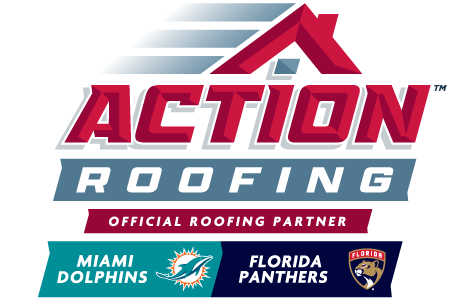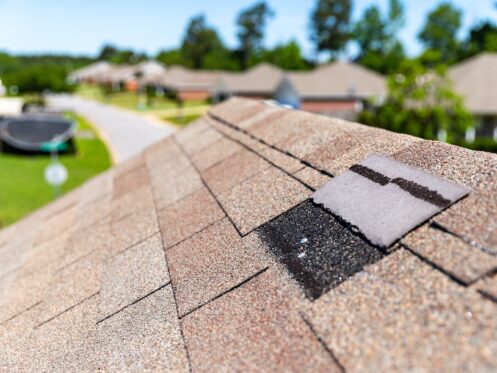With hurricane season fast approaching in South Florida, now is the time to evaluate whether your roof is ready to weather the storms ahead. High winds and driving rain can expose existing weaknesses, and roofs in poor condition are far more likely to suffer serious damage. Even the loss of a few shingles or tiles can lead to significant water intrusion and costly interior repairs.
While a little wear and tear doesn’t mean that your home needs immediate roof replacement, knowing the warning signs can help you make a smart, timely decision.
Roof Leaks
If your roof is leaking, it’s one of the clearest signs it may be time to consider a replacement, especially with hurricane season around the corner. Even small leaks can lead to moisture damage that weakens the underlying roof deck and framing. When these components are compromised, your roof is more vulnerable to wind uplift and storm damage. In South Florida, leaks can also quickly lead to mold growth in the attic, which may require expensive professional remediation if left unchecked.
Signs of a leak are often visible in your attic. If you notice stains, moisture, sagging wood, or any signs of rot or warping in the roof sheathing or support structures, your roof will likely no longer offer full protection. These early indicators shouldn’t be ignored when evaluating whether your roof can withstand the demands of hurricane season.
You Can See Light Through Your Roof
While inspecting your attic, check carefully for any spots where daylight is visible through the roof decking. If you see sunlight, it means there are gaps or missing materials. It’s a clear sign that your roof is no longer fully sealed. These weak points can allow rain to pour into your attic even during a mild storm, increasing the risk of water damage and potential mold growth.
Additionally, small vulnerabilities like loose shingles expose the underlayment, allowing water intrusion and leading to escalating structural issues. Over time, moisture entering through even minor breaches can weaken the roof decking and the rafters or trusses that support it.
Once this underlying structure is compromised, the cost of a roof replacement increases significantly. That’s because, if a roof is allowed to deteriorate, it’s not just the surface materials that need replacing. Damage to framing may also need to be reinforced or rebuilt entirely.
If you can see daylight through your roof, it’s not just a sign of wear and tear. It’s a red flag that your roof may not be ready for the demands of hurricane season. Acting early could prevent a relatively small issue from becoming a major, expensive rebuild.
Roof Has Started to Sag
If you notice any part of your roof starting to sag, it’s a strong sign that the structure beneath is compromised and may no longer be safe. Sagging usually means that the roof decking or support beams, such as rafters or trusses, have weakened, often due to moisture damage, rot, or long-term wear.
Because of the potential danger, roof inspection professionals typically won’t even walk on a sagging roof until they’ve performed a thorough attic inspection and ensured it’s safe. Replacing a sagging roof usually takes longer than a standard roof job because the damaged structural components need careful assessment and reinforcement or rebuilding. You should plan for additional time to complete these repairs, especially if you want your roof ready before hurricane season begins.
Shingles Are Curling
In South Florida’s hot climate, shingles endure significant wear and tend to deteriorate relatively quickly. This often causes the edges of shingles to curl and lift. Curled shingles pose particular risks during a hurricane. First, wind can more easily get underneath them, increasing the likelihood they’ll be torn off the roof. Second, rainwater can seep beneath the shingles rather than running off properly, leading to leaks in the attic and moisture damage to the wooden roof deck, which can cause rot over time.
Cracked or Missing Shingles or Roof Tiles
Cracked or missing shingles are another issue to watch out for. One reason is that this creates a much higher chance of the roof leaking during heavy rains. Any cracked shingles or tiles are also more likely to get broken by strong winds and ripped off the roof. If any shingles or tiles are missing, it increases the chances of the nearby shingles or tiles getting torn off during a hurricane as well.
Bald Spots on Shingles
The granules on shingles serve important purposes, including protecting the underlying fiberglass and asphalt from damage caused by sunlight and rain. As shingles age, these granules often begin to loosen and wash away, creating bald spots that leave the shingles exposed to the elements. This exposure accelerates asphalt deterioration, making the shingles more brittle and increasing the risk of cracking, breaking, or being torn off during a storm. When you see missing granules and widespread bald spots, it’s a clear sign that your shingles are nearing the end of their lifespan.
Roof Is 25 Plus Years Old
Metal roofing usually lasts 50+ years, and tile roofs can sometimes last for 75 years or more. Asphalt shingles, on the other hand, seldom hold up for more than 25 years. Some shingles are rated to last for 40 to 50 years, but this rating is misleading. That’s because it’s based on a best-case scenario where the shingles experience very little weathering and never get damaged. In Florida, some shingle roofs last only 15 to 20 years due to the extreme heat and humidity, which causes them to deteriorate more quickly.
The Importance of Getting Your Roof Inspected Before Hurricane Season
Many roof issues aren’t something you’ll be able to see without using a ladder and climbing up on your roof, which can be dangerous. Even if you go on your roof, it’s often difficult to spot all signs that indicate your roof should be replaced or repaired without a trained eye.
The best way to know what condition your roof is in and how likely it is to suffer major damage during a hurricane is to have an experienced, professional roofer perform a complete inspection. If the roofer finds any issues, you can save yourself a lot of money and hassle by getting the problems fixed or your roof replaced before hurricane season.
If a hurricane does end up hitting your home, you also want to make sure to have a roofing company perform a storm damage inspection afterward. Even if your roof is in good shape, a major hurricane is likely to cause at least some amount of damage. Getting any damage repaired promptly is crucial for avoiding major problems and ensuring your roof is in good enough shape to stand up should another hurricane hit.
Contact Your Local Roofing Pros
For the best residential and commercial roofing services in South Florida, look to Action Roofing. We’ve been providing reliable roof replacement and repair services for nearly 40 years and can help you get your roof ready for hurricane season.
Contact us today to schedule a roof inspection or learn about your roof replacement options.




